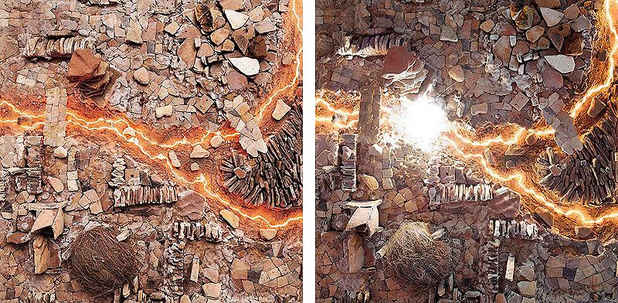Vivan Sundaram “Terraoptics”
sepiaEYE

[Image: Vivan Sundaram "Terraoptics 088" Photography Gireesh G.V.]
This event has ended.
sepiaEYE presents Terraoptics, a pioneering conceptual multi-media exhibition by one of India’s most prolific artists, Vivan Sundaram, that pairs two important bodies of work. Terraoptics includes installation-based video and photography that reference Sundaram’s ground-breaking work Black Gold (2012), a large-scale installation that debuted in the 2012 Kochi-Muziris Biennale. Sundaram is considered one of the few conceptualist artists of his generation in India, having gravitated from his accomplished practice as a painter in the early 1990s towards working with assemblage, photography, video, and installation.
Sundaram explains: “the material genesis of Terraoptics is the large site-specific installation made up of discarded potshards from Pattanam, Kerala. The potshards were from archaeological remains attributed to the ruins of the disappeared port-town of Muziris (100 B.C.-100 A.D.) The (50’ x15’) installation consisted of a hundred thousand terracotta pieces. The terrain of a denuded landscape, an urban ruin, was then flooded with black peppercorns and performatively shot.” The video, Black Gold (2012), was a three-channel floor projection shown separately.
“For Terraoptics the same potshards now become a series of miniature sets. Placed in trays and shot with a still camera positioned above, the terracotta assemblage becomes a relief, a flat-bed, picture-plane-it is also a riverine landscape with pre-historic formations and emblazoned habitation.” Sundaram continues: “The model in the darkroom is laid with light-wires into luminous planes, intricate patterns. One-millimeter-wide fiber-topics crisscross the terracotta forms. Optimal geometry, linear velocity, ‘light as speed’. The earth-body is made incandescent: it produces a terrestrial-optical consciousness. Artists play with temporal transpositions, seeking counterequilibrium for human (un)settlement.”
Sundaram brings together Black Gold’s powerful and poetic floor projection with a selection of the Terraoptics installation-based photograph series, first shown at a collateral exhibition to the 2016 Kochi Biennale. One of our curatorial goals at sepiaEYE is to retain and even enhance the individual power of Black Gold (2012) and Terraoptics (2016) by integrating them thoughtfully through a side-by-side and site-specific approach.
ABOUT THE ARTIST
Born in India in 1943, Vivan Sundaram is one of India’s most prolific artists. Sundaram’s work refers to perception, memory, history and their intersection with social problems and popular culture. Several of his recent collaborative projects, although very different in aesthetics, involve the use of photographs, found objects, video, and three-dimensional constructs. In these collaborations, Sundaram assumes the role of conductor and curator.
“[Re-Take of Amrita]… is basically an archival family album, a photographic souvenir of the distant past. Thanks to digital technology, however, the pictures are simultaneously old and new. They embody the past the way it survives in the mind: edited, layered, compressed, as if in a dream.” (Holland Cotter, The New York Times, 2008).
Trash explores the social implications and aesthetics of urban waste and secondhand goods. Constructing a huge and fantastical cityscape in his New Delhi studio entirely with garbage, the resulting composite photographs re-imagine the dreams and aspirations of the architect as grand city planner while simultaneously poking fun at the folly of such utopian misadventures. The color and texture of industrial waste, dirty toothbrushes, plastic toys, tin cans, and a sea of empty yogurt containers create panoramas both astonishing and absurd. Sundaram’s work has been included in countless solo and group exhibitions and international biennials including Shanghai, Johannesburg, Kwangju, as well as in institutions such as; Herning Kunstmuseum; The Queens Museum of Art, New York; Fukuoka Asian Art Museum; National Gallery of Modern Art, New Delhi; and Tate Modern, London. In 2008 his work was shown in “Archive Fever: Uses of the Document in Contemporary Art,” at the International Center of Photography, New York. The artist has published over ten books, most recently, Trash (2008), Amrita Sher Gil: An Indian Artist Family of the 20th Century (2007) and Re-take of Amrita (2006).
Media
Schedule
from May 10, 2017 to June 24, 2017
Opening Reception on 2017-05-09 from 18:00 to 20:00